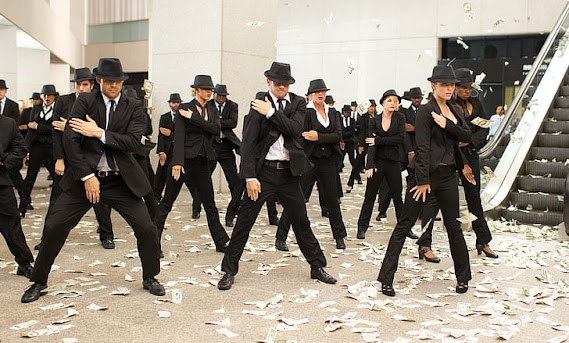Gold Diggers of... 2006??
Six months ago, I launched our current series of films, which I have been calling Depression/Comedy.
At the time, I spoke (perhaps controversially) about my reasons for presenting this series. When times are bad, suffering can be seductive, and it is all too easy to allow the suffering to define you. The pain, the misery, the anger can become your identity, and before you know it, that is all that everyone else can see.
What I hope I have been able to convey in this series is how hard film-makers of the 1930s worked to avoid that. Things may be awful, but that doesn't mean we have to abandon art, and it doesn't mean that any art that is produced has be about nothing but the awfulness.
At the same time, it is not necessary to completely ignore the hardships we are facing. It is possible to acknowledge painful realities without allowing that pain to become the be-all and the end-all of existence. If anything, Bad Times make it more important than ever to hold on to all the other things that can define us. Otherwise, when (and if) those bad times change, we may find that we are defined by Nothing.
If pain and rage is our only identifier, then taking away that pain takes away our identity. It's all too easy to become dependent on that pain for one's sense of self, and that's why holding on to something positive is so important.
All of this philosophical meandering is the preamble to my announcement of this, the final phase in our exploration of Depression/Comedy.
Over the next few weeks, I want to explore Busby Berkeley.
And his legacy.
Step Up: 1933
In a nutshell, Busby Berkeley was a dance director who choreographed the elaborate and frankly bonkers musical sequences in several Warner Brothers musicals of the early 1930s. I intend to focus on three of those musicals: 42nd Street, Gold Diggers of 1933 and Footlight Parade (all released in 1933).
To call these musicals influential is a masterpiece of understatement.
All three films are very much products of the Depression. They make no attempt to hide from the hardships that everyone was facing at that time - in fact those hardships are actually central to the plot. They also set the standard for every subsequent backstage "let's-put-on-a-show" style musical in the way they focus on the sweat, the grind and the back-breaking hard work that goes into mounting a musical production.
This is the paradox at the centre of all the classic Busby Berkeley musicals: they tell stories that are firmly grounded in the reality around them while they simultaneously feature some of the most extravagant, insane and (bluntly) implausible dance numbers ever committed to film.
But for all their focus on the harsh reality of putting on a show in the Depression, these films are not remotely downbeat. They might be set in a tough, unforgiving environment that threatens to beat them all down, but they tell a story of strong, determined characters who pull together to make their lives stand for something.
It's a compelling template, and one that was to become the basis for another set of dance films, made over seventy years later.
Gold Diggers in the 21st Century
The "Step Up" franchise consists of a series of films released between 2006 and 2014, each telling an (almost) unconnected story about a group of dancers who come together in very difficult circumstances to prove to the world (and to themselves) that they are more than the product of their difficult environment.
The Busby Berkeley films were not a "franchise" in the modern sense. There was no continuity of characters or situations, but they all featured the same performers, the same song-writers and the same dance director.
The Step Up films are held together equally tenuously, with each one telling an unrelated story that nonetheless connects itself to the others in the series.
It's not too much of a stretch to say that had the Busby Berkeley films continued into the 21st Century, this is what they would be.
Starting this week, I plan to show the Busby Berkeley films and the Step Up films... concurrently:
Thursday, the 13th of June:
Step Up (2006)
Thursday, the 20th of June
42nd Street (1933)
Thursday, the 27th of June
Step Up 2 The Streets (2008)
Thursday the 4th of July
Gold Diggers of 1933 (1933!)
Thursday, the 11th of July
Step Up 3D (2010)
Thursday, the 18th of July
Footlight Parade (1933)
Thursday, the 25th of July
Step Up Revolution (2012)
Thursday, the 1st of August
Step Up All In (2014)
It is, by the way, a reflection of the changing nature of Hollywood that the Step Up movies were produced over eight years, between 2006 and 2014. The equally lavish Busby Berkeley films were produced over seven months, between March and October of 1933.





























Comments
Post a Comment